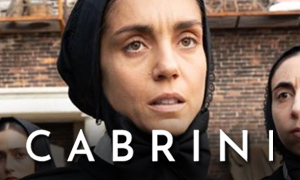The Favourite: History vs. Hollywood
| REEL FACE: | REAL FACE: |
Olivia Colman
Born: January 30, 1974 Birthplace: Norwich, Norfolk, England, UK | Queen Anne
Born: February 6, 1665 Birthplace: St James's Palace, Westminster, England Death: August 1, 1714, Kensington Palace, England (stroke) Image: Portrait by Michael Dahl, 1705 |
Rachel Weisz
Born: March 7, 1970 Birthplace: Westminster, London, England, UK | Sarah Churchill, Duchess of Marlborough
Born: June 5, 1660 Birthplace: St Albans, England Death: October 18, 1744, Marlborough House, England Image: Portrait by Sir Godfrey Kneller, 1702 |
Emma Stone
Born: November 6, 1988 Birthplace: Scottsdale, Arizona, USA | Abigail Masham
Born: c. 1670 Birthplace: London, England Death: December 6, 1734, England Image: Portrait by Unknown Artist, c. 1700 |
Nicholas Hoult
Born: December 7, 1989 Birthplace: Wokingham, Berkshire, England, UK | Robert Harley
Born: December 5, 1661 Birthplace: Covent Garden, England Death: May 21, 1724, Westminster, England |
Mark Gatiss
Born: October 17, 1966 Birthplace: Sedgefield, England, UK | John Churchill, 1st Duke of Marlborough
Born: May 26, 1650 Birthplace: Ashe House, England Death: June 16, 1722, Windsor Lodge, England (stroke) Image: Portrait by Sir Godfrey Kneller, c. 1702 |
When did Anne Stuart become queen?
The Favourite true story reveals that Anne Stuart became Queen of England, Scotland and Ireland following the death of King William III in 1702. William's wife (who was also his first cousin), Queen Mary II, had died eight years earlier in 1694. William and Mary were not Anne's parents. Anne's father, King James II, had been removed from the throne in 1688 by William of Orange, his son-in-law, during the Glorious Revolution.
King James II was deposed on religious grounds. He had been previously converted to Catholicism by his wife, Anne's mother. After her mother's death, James married the catholic princess Mary of Modena and they bore a son, James. This changed the line of succession from Jame's daughter Mary, a protestant, to his newly born son, a catholic. The protestants of England saw this as a threat that would inevitably lead to the formation of a Roman Catholic dynasty across the kingdoms. Anne defied her father and took the protestant side of William and her sister, Mary. Upon his removal, James fled to France with his wife and son, and William and Mary ascended to the throne. Anne was next in line.
Was Queen Anne sick and mostly bedridden?
Yes. A fact-check of The Favourite movie confirms her battle with gout caused her a great deal of pain, and she put on weight due to her sedentary lifestyle. She was eventually carried around the Palace in a wheelchair or sedan chair. Like in the movie, this proved to be difficult for her since she had taken an active interest in foreign policy and affairs of the state. She also suffered from an eye condition that caused excessive eye watering. -Mirror Online
Had Anne been pregnant 17 times?
Yes, and tragically, 12 of the 17 times she was pregnant she either miscarried or had stillborn births. Of her five children who survived birth, four died before their second birthday and her only remaining child, Prince William, Duke of Gloucester, died in 1700 at age 11. -Mirror Online
Did Queen Anne really have bunnies in her bedchamber?
No. The real Queen Anne didn't keep 17 pet rabbits as stand-ins for the children she lost due to miscarriages, still births and premature death. The movie's historical consultant, Hannah Greig, has admitted this is fiction, stating, "Pet rabbits would never have been found lolloping around a royal bedchamber: They were an early 18th-century foodstuff and pest." -History Extra
How did Lady Sarah and Queen Anne meet?
Anne met Sarah Churchill (née Jennings) in the court of Anne's uncle, King Charles II, when she was around the age of 8 and Sarah was 13 (Vanity Fair). Sarah's father had been friends with Anne's father, James II, when he was still Duke of York. Sarah, Duchess of Marlborough, was maid of honor to Jame's second wife, Mary of Modena. Not long after, Sarah became close friends with Anne in 1675.
They remained close and Sarah became Lady of the Bedchamber when Anne married Prince George of Denmark in 1683. After Anne's ascension to the throne in 1702, their friendship deepened and Lady Sarah was made Mistress of the Robes (the top rank for a woman in the royal court), Keeper of the Privy Purse, Groom of the Stole, and Ranger of Windsor Great Park. By that time, the pair had long referred to each other by pet names. Sarah was "Mrs. Freeman" and Anne "Mrs. Morley".
Did Lady Sarah really have that much influence over Queen Anne?
Yes. The Favourite true story confirms that not only did the attractive Sarah control Queen Anne's finances and circle of friends, she had a reputation for being brutally honest with Anne. Sarah's advice was sought regarding everything. This may have been in part due to the fact that Anne's education was "astonishingly inadequate", according to one biographer. Anne was also shy and found impromptu conversation a challenge, unlike the more outspoken and intelligent Lady Sarah (It was even said that when Anne found herself out of her element in a conversation, she would sometimes move her lips and pretend to continue speaking). It is believed that Sarah largely used her friendship with Anne for personal gain more than anything else. She once commented that she'd rather be "in a dungeon" than in a conversation with the tedious royal. -Vanity Fair
Queen Anne's reign was marked by three major developments: the establishment of a two-party Parliamentary system, England's role in the War of the Spanish Succession, and the 1707 Act of Union which unified England and Scotland as one kingdom under the name "Great Britain". The last development is not depicted in the movie.
How did the rift between Queen Anne and Lady Sarah begin?
Queen Anne was a strong supporter of the Tories, who backed the Anglican Church and supported the landed gentry. Lady Sarah, on the other hand, had become an advocate of the the Tories' rivals, the Whigs, in part due to their support of Britain's role in the War of the Spanish Succession. Sarah's husband, the Duke of Marlborough, was Captain-General of the army and had emerged victorious in several key battles.
Sarah, the second most powerful woman in the country, often chose not to attend court, which aggravated Anne even more. The schism between them was made worse by Anne's growing fondness for Abigail Hill, a servant who had been brought into the household by her cousin, Sarah, and was appointed Lady of the Bedchamber around 1704. Anne had come to prefer Abigail's more flattering gentle approach over Sarah's tell-it-like-it-is demeanor. However, Sarah believed that Abigail's flattery was more a strategy to manipulate Anne, rather than something genuine.
Is the clothing seen in the movie accurate to the period?
No. Our fact-check of The Favourite movie revealed that costume designer Sandy Powell's stunning outfits are not typical of the era. In the film, the leading ladies wear monochrome popping with vivid patterns and African-inspired prints. Court servants are dressed in recycled denim. It's not accurate historically and is symbolic of the film's tendency to paint outside the lines when it comes to the truth. "Some of the things in the film are accurate and a lot aren't," director Yorgos Lanthimos told The Hollywood Reporter.
Had Abigail really been poor?
Yes. Born Abigail Hill, her family had gone broke because of her father's gambling. Sarah likely helped her get a job in the Queen's service more out of embarrassment than the goodness of her heart. -Vulture
Were there sexual relationships between Anne and Sarah, and Anne and Abigail?
No, this is highly unlikely. While there have been rumors of sexual relationships between both Queen Anne and Lady Sarah, and Queen Anne and Abigail Hill, most historians and biographers reject this notion. The movie uses the fictionalized love triangle to heighten the drama and add another dimension to the rivalry between Anne and Sarah. It also omits Anne's husband, Prince George of Denmark, with whom she had a prolific sexual history that resulted in 17 pregnancies, which are noted in the movie. Biographers cite that Anne was a woman with a strong sense of Christian morality who was devoted to her husband. She shared a room with him and did not ever leave his bed in all his years of dwindling health. Thus, it would have been logistically very difficult for Anne to carry on extramarital affairs.
Lady Sarah was the wife of John Churchill (aka Lord Marlborough), who she married out of love in a secret ceremony in the winter of 1677-78. Lord Marlborough is portrayed in the movie by Mark Gatiss. In real life, they had seven children together. Sarah did come to court and reportedly circulated a risqué poem believed to have been written by Whig propagandist Arthur Mainwaring, which suggested that there was a lesbian relationship between Anne and her chambermaid, Abigail Hill. Historians largely believe that Sarah circulated it out of jealousy rather than truth. The ballad read:
Sarah could see that she was slowly being replaced as the favourite and such an accusation would hopefully cause Anne to cut ties with Abigail, or even lose the crown, which would benefit Sarah politically as well. In a letter to Anne, Sarah told her that she was hurting her reputation by developing "a great passion for such a woman ... strange and unaccountable." Writing further about Abigail, Sarah stated, "I never thought her education was such as to make her fit company for a great queen. Many people have liked the humor of their chambermaids and have been very kind to them, but 'tis very uncommon to hold a private correspondence with them and put them upon the foot of a friend."
Some modern commentators and filmmakers choose to conclude that Anne was a lesbian, but that's more an embrace of today's social movements than it is a reflection of historical fact. The real Sarah never mentioned that Anne had ever been attracted to her and she struck down any notion that her own relationship with Anne had ever been sexual, which would have given more credence to the suggestion of an affair with Abigail, given that Sarah's friendship with Anne was more intense than Anne and Abigail's. In addition, the film not treating such relationships as taboo is unrealistic for the time, something director Yorgos Lanthimos admitted to approaching with little regard for historical accuracy. -IndieWire
Is Nicholas Hoult's character, Robert Harley, portrayed accurately in the film?
No. For one, Tory leader Robert Harley was not an attractive young 20-something during the reign of Queen Anne. He was instead a somewhat morose-looking man in his early 40s. While it's true that Harley became Abigail's confidant, the two were actually related in real life. They were cousins on her father's side. It's possible that along with Sarah, Harley helped Abigail get the job in the Queen's service. -Vulture
When did Lady Sarah realize she was being supplanted by Abigail as the Queen's favourite?
Sarah (aka the Duchess of Marlborough) realized she was no longer Queen Anne's favourite in 1707 after she learned that Abigail had married Samuel Masham, a groom in the bedchamber of Anne's husband. The once-destitute Abigail had become Lady Masham. Sarah was furious over Anne and Abigail's closeness, and became more upset after she learned that the Queen had attended her chambermaid's wedding and gave the couple a dowry of £2000 paid from the Privy Purse, which Sarah managed. -Mirror Online
Did Sarah threaten to expose letters that Anne had written to her?
Yes. In researching The Favourite true story, we learned that Sarah threatened to blackmail Anne by exposing the most provocative of Anne's letters to her. They included excerpts like, "I hope I shall get a moment or two to be with my dear…that I may have one embrace, which I long for more than I can express," and "I can't go to bed without seeing you…If you knew in what condition you have made me, I am sure you would pity." Though it would be uncommon for two straight women to exchange such letters today, deeply affectionate language between friends of the same sex wasn't uncommon in that era. Such friendships between women were typically referred to as "romantic friendships."
Did Sarah try to force Queen Anne to dismiss Abigail from the court?
Yes, but it was attempted more for political reasons than personal ones. Sarah, who had aligned herself with the Whigs, wanted to remove Abigail and her Tory sympathies from the court, knowing they would influence Queen Anne. Sarah treated Anne's emotional defense of her chambermaid Abigail as an indication of a lesbian affair, which made Anne even more upset. Sarah hoped the rumors she was spreading would cause the Queen to remove Abigail from her service, realizing that it threatened her reputation. It instead did the opposite and led to Sarah's falling out with Anne. When asked what ended their friendship, the Queen would later say that the main reason was Sarah "saying shocking things" about her and to her. -Vulture
When did Queen Anne's husband, Prince George, die?
Prince George, who became Lord High Admiral when his wife Anne became Queen, died in 1708, six years into her 12-year reign. Anne's husband George is not included in the The Favourite movie. Yet, in real life, his death deepened the rift between Lady Sarah and Queen Anne, as Sarah refused to wear mourning clothes, which implied that she thought Anne's grief was fake. Sarah indicated this in the hours following George's death, by stating, "[Although Anne’s] love to the Prince seemed . . . to be prodigiously great . . . her stomach was greater, for that very day he died she eat [sic] three very large and hearty meals" (Private Correspondence of Sarah, Duchess of Marlborough).
Sarah was cold with the grieving Anne, who preferred Abigail's compassionate and comforting disposition instead. Sarah further upset Anne by suggesting that Anne switch palaces to avoid reminders of her husband. She also had a portrait of George removed from Anne's bedroom. -Mirror Online
Did the rivalry between Lady Sarah and Abigail Hill really become as heated in real life?
No. In exploring The Favourite true story, we discovered that the rivalry did not reach the life and death stakes seen in the movie. Much of the rivalry was born out of the fact that Sarah and Abigail opposed each others politics. As Abigail wielded more influence over Queen Anne, she started urging the Queen to embrace her natural Tory inclinations. The Whig-minded Sarah saw Abigail as a threat to the political agenda of the Whig Party.
Did Abigail ever poison Sarah?
No. A fact-check of The Favourite movie reveals that this is fiction. There is no historical evidence to suggest that Abigail poisoned Sarah. -Vulture
Did Lady Sarah and her husband leave England?
Yes. When the War of the Spanish Succession (largely seen as a Whig project) fell out of favor with the British public, the Whigs in turn lost the election of 1710, which we see in the movie. Queen Anne dismissed Sarah's husband, the Duke of Marlborough, on trumped-up embezzlement charges. This was at a time when the Whigs were losing influence and the Tories were gaining more control. As Whig supporters, Sarah and her husband were a point of contention for the Tory-minded Queen.
Sarah's final encounter with Queen Anne took place in 1710 when Sarah attempted to mend their ailing friendship. According to Sarah's accounts of the meeting, Anne coldly cast her off. Sarah responded by telling Anne that God would judge her for the way that she had treated her. Sarah knew that attacking Anne on a religious level would upset her, which it did.
In 1711, the Queen stripped Sarah of her roles in the royal court. Abigail, who had become Baroness Masham, replaced Sarah as Keeper of the Privy Purse. Public funding for Blenheim Palace, the Queen's gift to Sarah and her husband following his victories in the War of the Spanish Succession, was halted. They left England for the courts of Europe, where Sarah's husband found success. She, however, mourned the position she had lost. -Mirror Online
Did Lady Sarah ever return to England?
Yes. Lady Sarah and her family returned to England on the afternoon of Queen Anne's death on August 1, 1714. It was rumored that Anne had asked for them to come back. With Anne's passing, the Tories fell from power, and the Whigs, including Sarah's husband, became the ruling majority again.
Queen Anne was succeeded by George of Hanover. King George got along splendidly with Sarah and her husband, and they became great friends. Sarah passed away in 1744 at age 84, but not before she had again become a favourite of a Queen, this time King George II's wife, Queen Caroline. However, Sarah's fiery disposition led to a falling out with them too.
What happened to the real Abigail Masham?
After Sarah was removed from the royal court, Abigail took her place. Anne was more cautious with Abigail, not wanting to be domineered as she had been with Sarah. She didn't want to elevate Abigail's status too much, for fear that Abigail would leave her.
Upon Anne's death from a stroke on August 1, 1714, Abigail Masham and her husband Samuel were evicted from their palace homes. Abigail left the court and retired into private life. Samuel purchased a manor house not far from Windsor. They were by no means poor. Abigail lived in their country house until her own passing in 1734. -Vanity Fair
Is Sarah Churchill related to Winston Churchill?
Yes. Lady Sarah Churchill's lineage guaranteed an enduring foothold in British politics. Her most famous descendant is Winston Churchill, who helped to save Britain from the hands of the Nazis during World War II. Sarah is also related to Lady Diana Spencer (Princess Diana) through her daughter, Anne Churchill, whose married name was Spencer.
The Favourite's Historical Accuracy Videos
Watch our episode below that fact-checks The Favourite for historical accuracy. Then watch our video explaining the significance of the bunnies, and finally, check out the movie's trailer.







